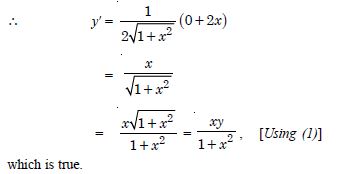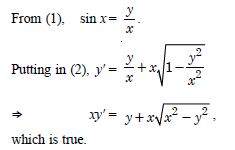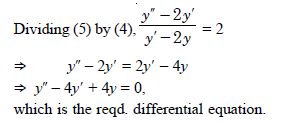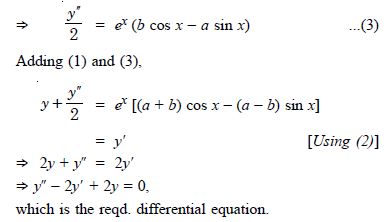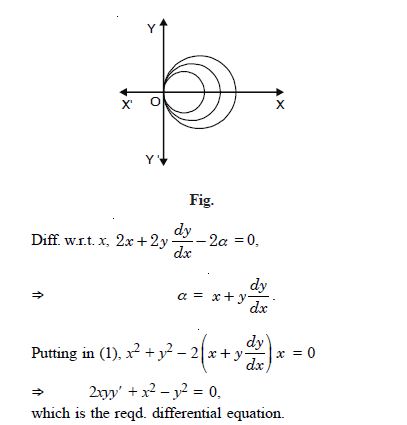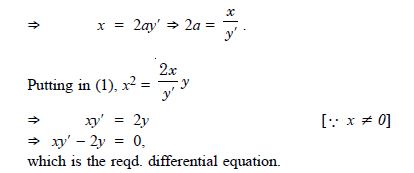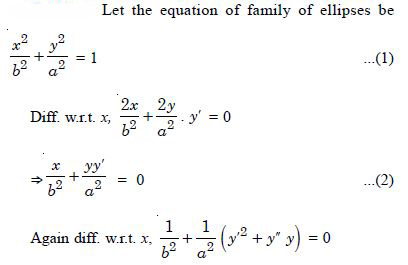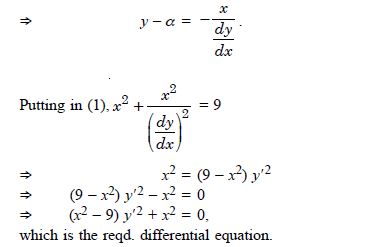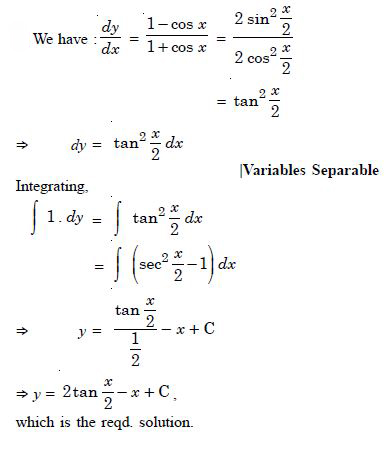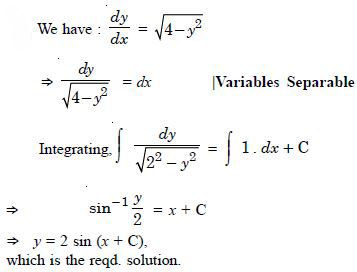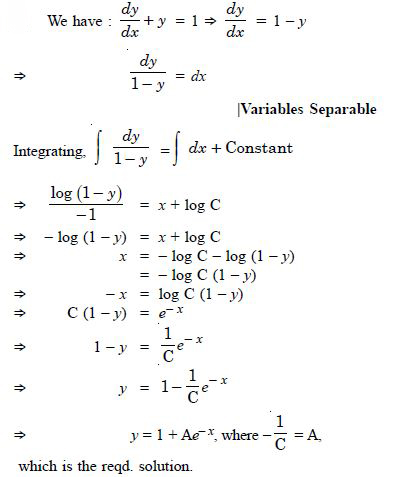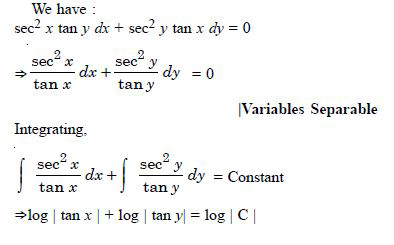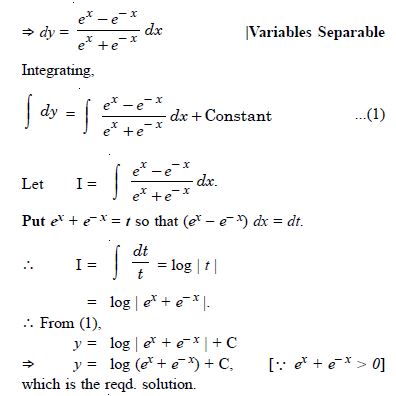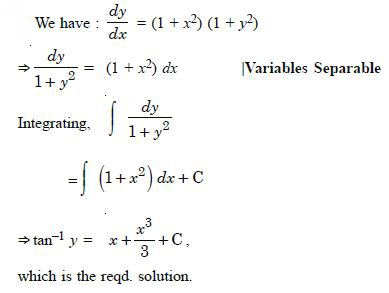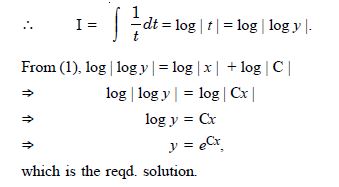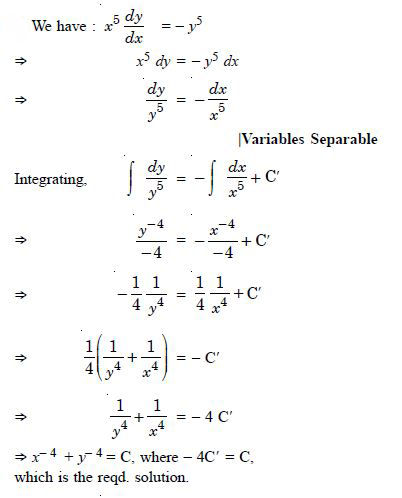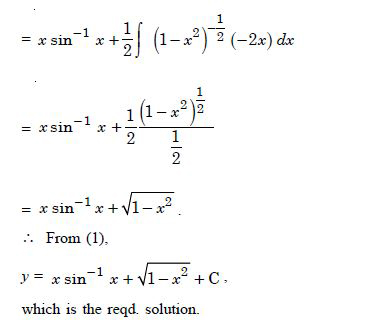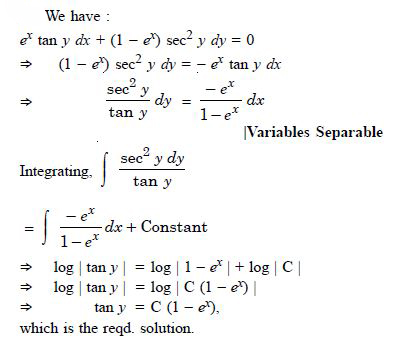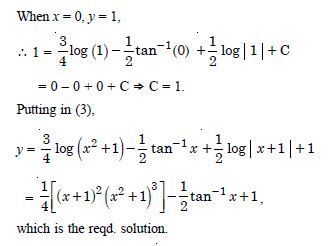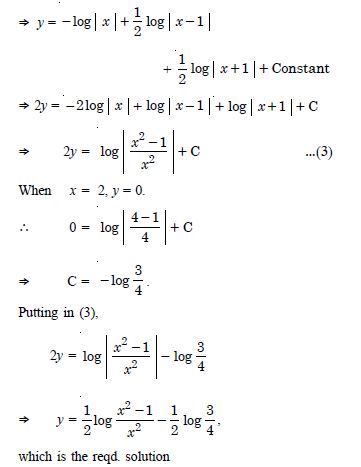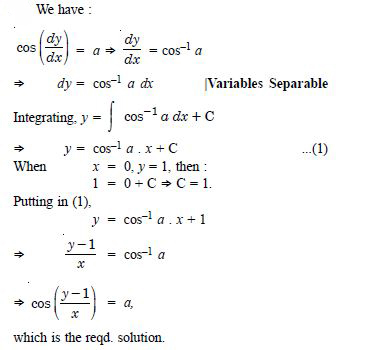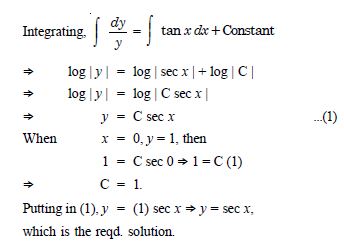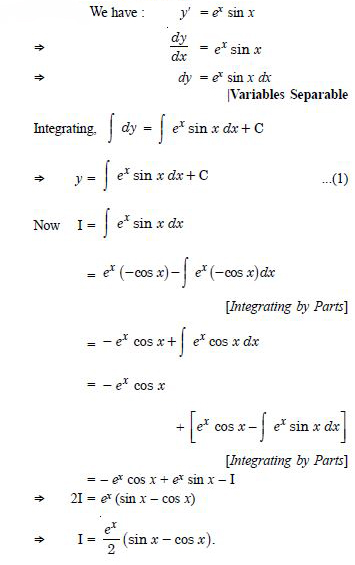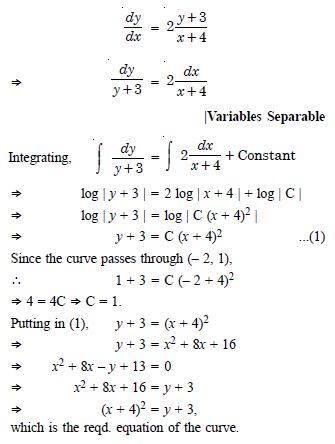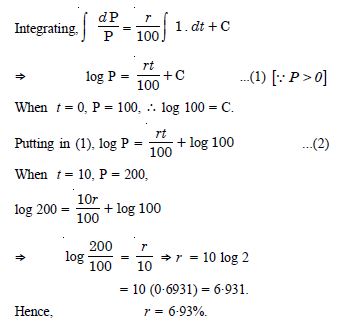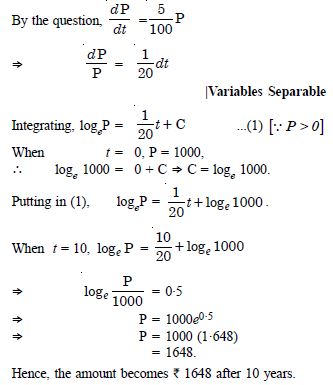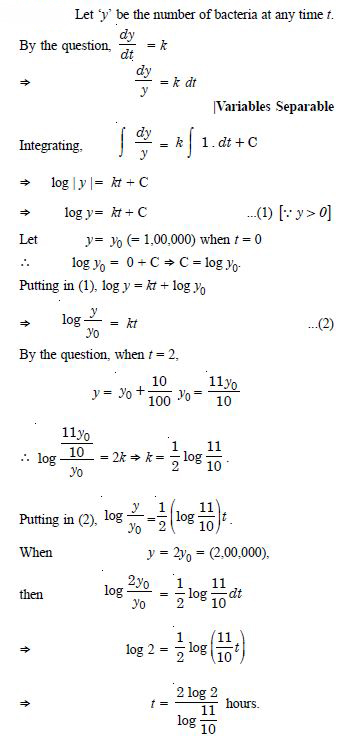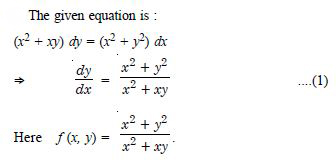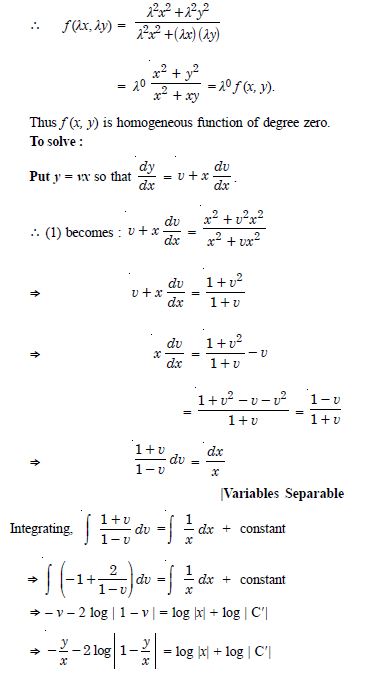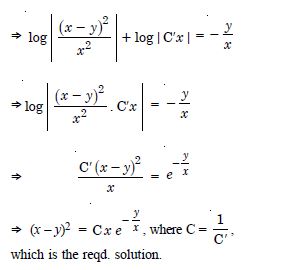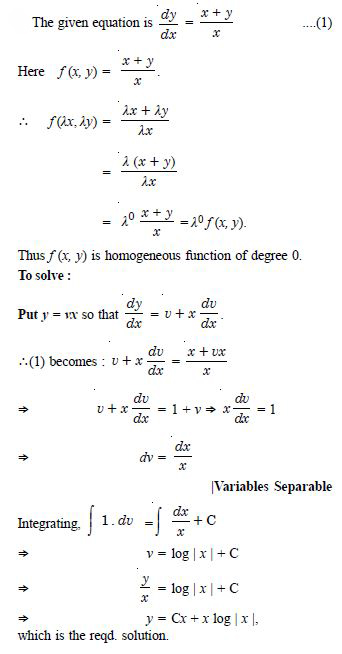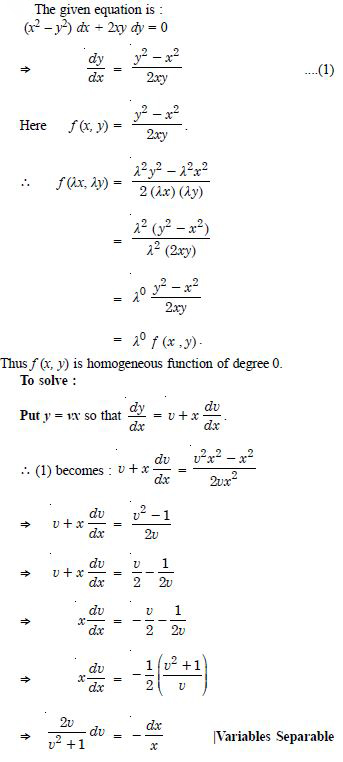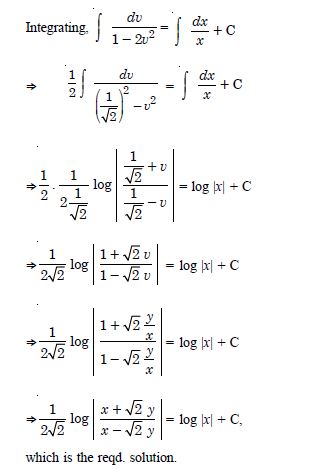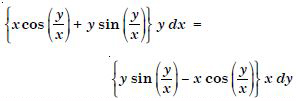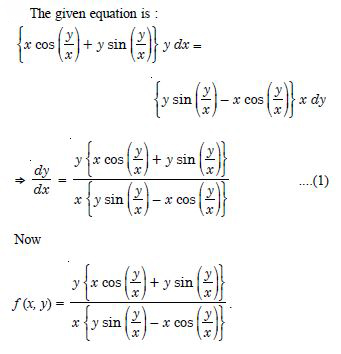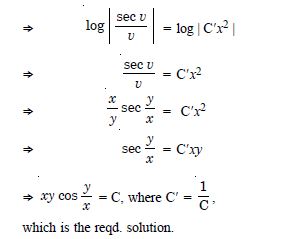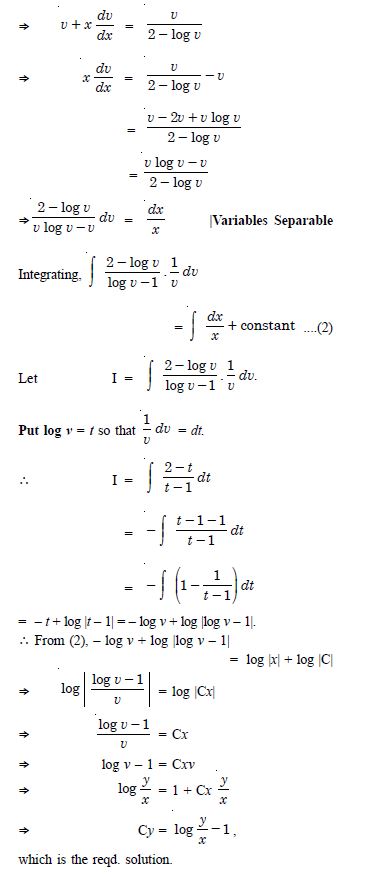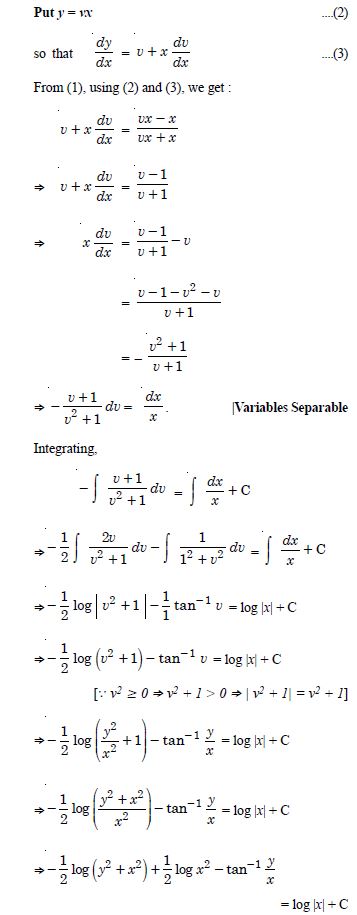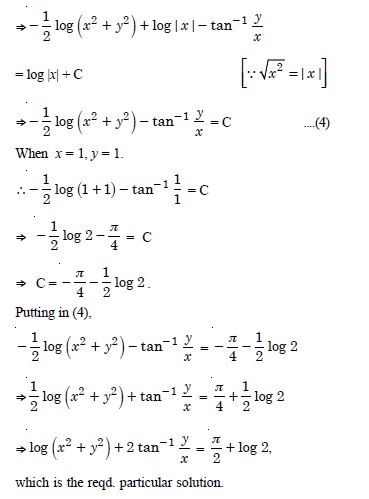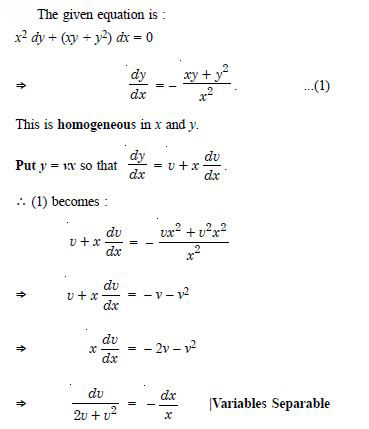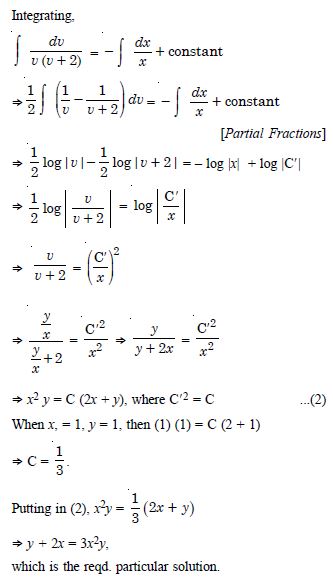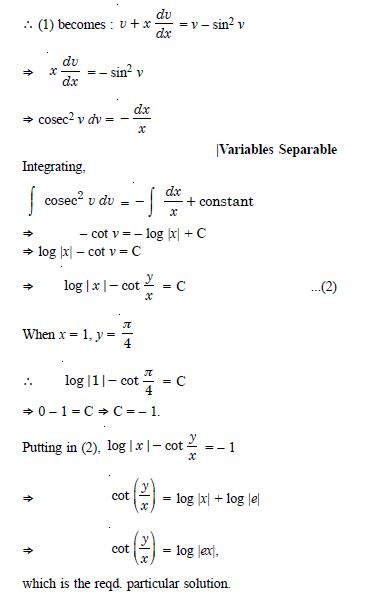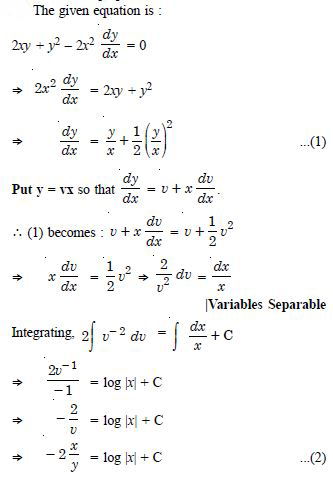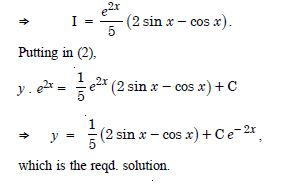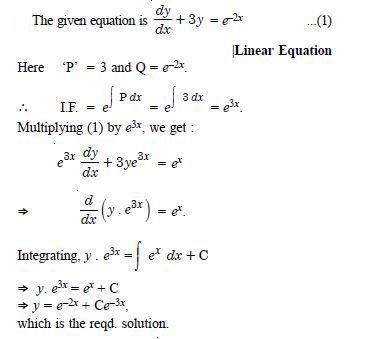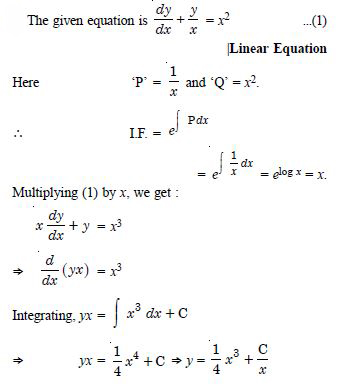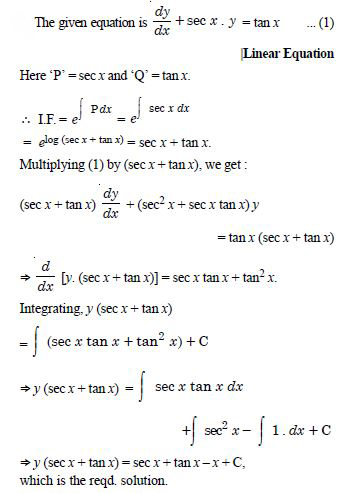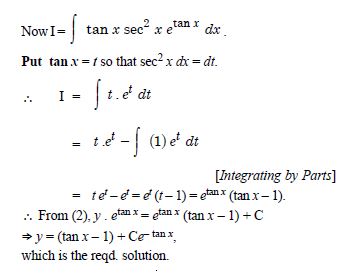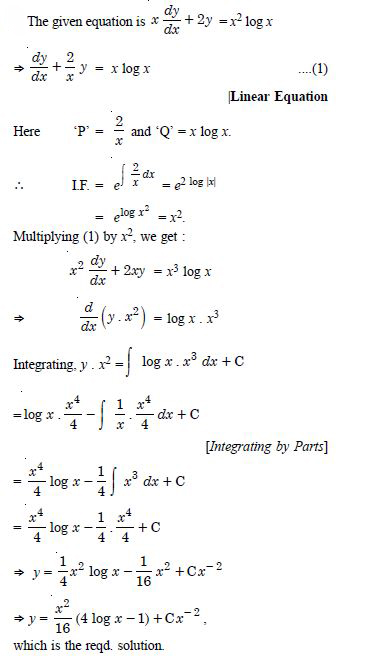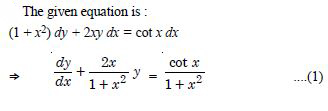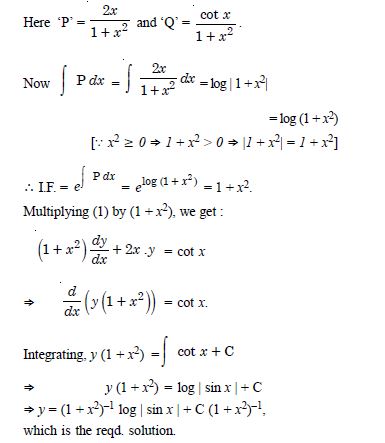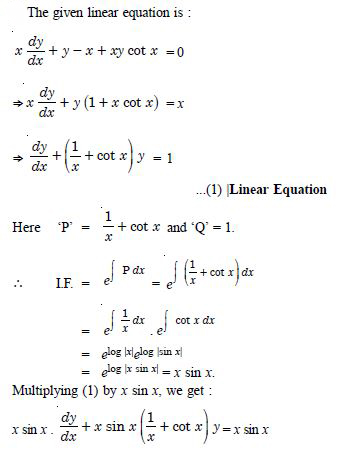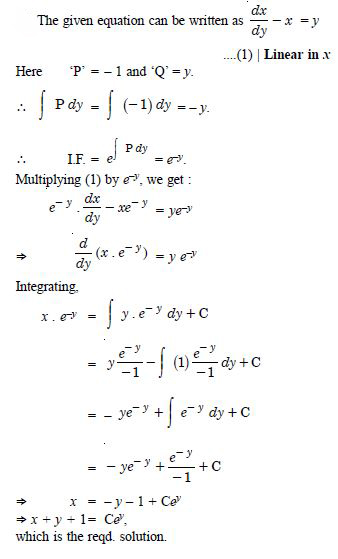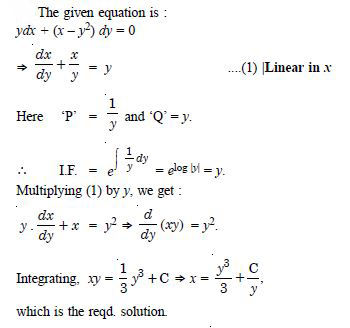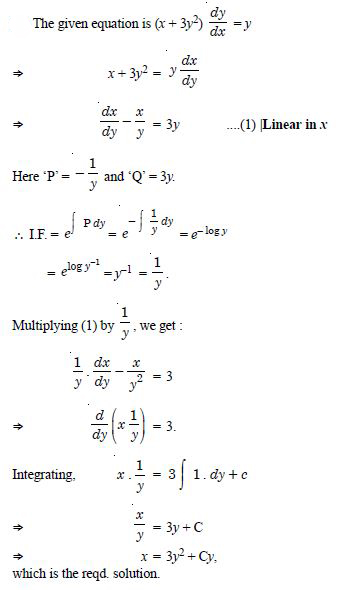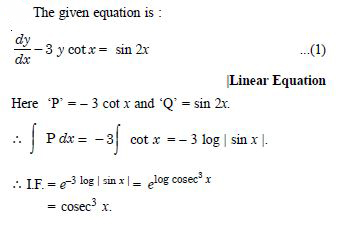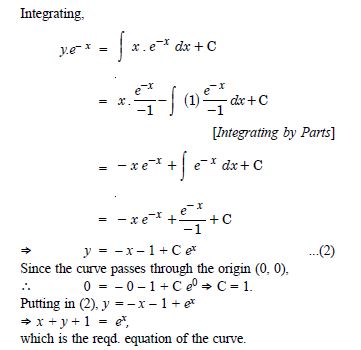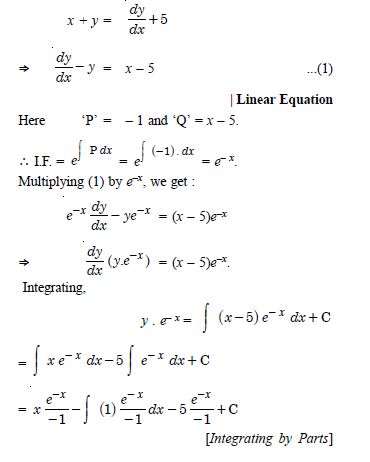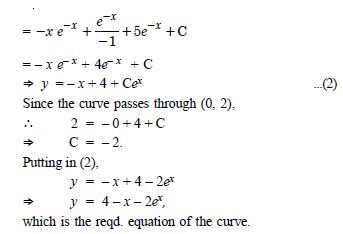Question 1:
Determine order and degree (if defined) of differential equations given in
Answer:
Order Degree
4 Not a polynomial in derivatives
Question 2:
Determine order and degree (if defined) of differential equations given in y' + 5y = 0.
Answer:
Order Degree
1 1
Question 3:
Determine order and degree (if defined) of differential equations given in
Answer:
Order Degree
2 1
Question 4:
Determine order and degree (if defined) of differential equations given in
Answer:
Order Degree
2 Not a polynomial in derivatives
Question 5:
Determine order and degree (if defined) of differential equations given in
Answer:
Order Degree
2 1
Question 6:
Determine order and degree (if defined) of differential equations given in
(y''')2 + (y'')3 + (y')4 + y5 = 0.
Answer:
Order Degree
3 2
Question 7:
Determine order and degree (if defined) of differential equations given in
y''' + 2y'' + y' = 0.
Answer:
Order Degree
3 1
Question 8:
Determine order and degree (if defined) of differential equations given in
y'+ y = 0.
Answer:
Order Degree
1 1
Question 9:
Determine order and degree (if defined) of differential equations given in
y''+ (y')2 + 2y = 0.
Answer:
Order Degree
2 1
Question 10:
Determine order and degree (if defined) of differential equations given in
y''+ 2y'+ sin y = 0.
Answer:
Order Degree
2 1
Question 11:
The degree of the differential equation :
- 3
- 2
- 1
- not defined
Answer:
not defined
Question 12:
The order of the differential equation :
- 2
- 1
- 0
- Not defined.
Answer:
2
Question 13:
Verify that the given function (explicit or implicit) is a solution of the corresponding differential equation :
y = ex + 1 : y''– y'= 0
Answer:
We have : y = ex + 1.
y' = ex and y'' = ex ... (1)
Now y''– y' = ex – ex [Using (1)]
= 0, which is true.
Question 14:
Verify that the given function (explicit or implicit) is a solution of the corresponding differential equation :
y = x2 + 2x + C : y'– 2x – 2 = 0.
Answer:
We have : y = x2 + 2x + C.
y'= 2x + 2
y'– 2x – 2 = 0, which is true.
Question 15:
Verify that the given function (explicit or implicit) is a solution of the corresponding differential equation :
y = cos x + C : y' sin x = 0
Answer:
We have : y = cos x + C.
y' = – sin x + C
y' + sin x = 0, which is true.
Question 16:
Verify that the given function (explicit or implicit) is a solution of the corresponding differential equation :
Answer:
Question 17:
Verify that the given function (explicit or implicit) is a solution of the corresponding differential equation :
y = Ax : xy'= y (x 0)
Answer:
We have : y= Ax ...(1)
y'= A.
Putting the value of A in (1),
y = y' x xy' = y,
which is true.
Question 18:
Verify that the given function (explicit or implicit) is a solution of the corresponding differential equation :
Answer:
We have : y = x sin x ...(1)
y' = x cos x + sin x . 1
y'= sin x + x cos x ...(2)
Question 19:
Verify that the given function (explicit or implicit) is a solution of the corresponding differential equation :
Answer:
Question 20:
Verify that the given function (explicit or implicit) is a solution of the corresponding differential equation :
y – cos x = x : (y sin y + cos y + x)y'= y.
Answer:
We have : y – cos y = x ...(1)
Diff. w.r.t. x, y'+ sin y . y'= 1
(1 + sin y) y'= 1
(y + y sin y)y' = y ...(2) [Multiplying by y]
From (1), y = x + cos y.
Putting in (2), (x + cos y + y sin y) y'= y
(y sin y + cos y + x) y'= y, which is true.
Question 21:
Verify that the given function (explicit or implicit) is a solution of the corresponding differential equation :
x + y = tan–1 y : y2y'+ y2 + 1 = 0
Answer:
We have : x + y = tan–1 y.
1 + y2 + y'(1 + y2) = y'
1 + y2 + y'(1 + y2 – 1) = 0
1 + y2 + y'y2 = 0
y2y' + y2 + 1 = 0, which is true.
Question 22:
Verify that the given function (explicit or implicit) is a solution of the corresponding differential equation :
Answer:
Question 23:
The number of arbitrary constants in the general solution of a differential equation of fourth order is :
- 0
- 2
- 3
- 4
Answer:
4
Question 24:
The number of arbitrary constants in the particular solution of a differential equation of third order is :
- 3
- 2
- 1
- 0
Answer:
0
Question 25:
Form a differential equation representing the given family of curves by eliminating arbitrary constants a and b :
Answer:
Question 26:
Form a differential equation representing the given family of curves by eliminating arbitrary constants a and b :
y2 = a (b2 – x2)
Answer:
We have : y2 = a (b2 – x2) ...(1)
Diff. w.r.t. x, 2yy' = a (0 – 2x)
yy' = – ax ...(2)
Again diff. w.r.t. x, yy'+ y'2 = – a ...(3)
Dividing (3) by (2),
xyy''+ x y'2 – yy' = 0,
Question 27:
Form a differential equation representing the given family of curves by eliminating arbitrary constants a and b :
y = ae3x + be–2x
Answer:
We have : y = ae3x + be– 2x ...(1)
Diff. w.r.t. x, y' = 3ae3x – 2b e–2x ...(2)
Again diff. w.r.t. x, y' = 9ae3x + 4be– 2x ...(3)
Multiplying (1) by 2,
2y = 2ae3x + 2be–2x ...(4)
Adding (2) and (4), y''+ 2y = 5ae3x
Question 28:
Form a differential equation representing the given family of curves by eliminating arbitrary constants a and b :
y = e2x (a + bx)
Answer:
We have : y = e2x (a + bx) ...(1)
Diff. w.r.t. x, y'= e2x (b) + 2e2x (a + bx)
y'= e2x (2a + b + 2bx) ...(2)
Multiplying (1) by 2, 2y = e2x (2a + 2bx) ...(3)
Subtracting (3) from (2),
y'– 2y = be2x ...(4)
Again diff. w.r.t x, y''– 2y'= 2be2x ...(5)
Question 29:
Form a differential equation representing the given family of curves by eliminating arbitrary constants a and b :
y = ex (a cos x + b sin x).
Answer:
We have : y = ex (a cos x + b sin x) ...(1)
Diff. w.r.t. x,
y''= ex (– a sin x + b cos x)
+ ex (a cos x + b sin x)
y''= ex [(a + b) cos x – (a – b) sin x] ...(2)
Again diff. w.r.t. x,
y''= ex [– (a + b) sin x – (a – b) cos x]
+ ex [(a + b) cos x – (a – b) sin x]
y'' = ex [2b cos x – 2 a sin x]
Question 30:
Form the differential equation of the family of circles touching the y-axis at origin.
Answer:
Let (, 0) be the centre of any member of the circles. Then the equation of the family of circles is :
(x – )2 + y2 =2 x2 + y2 – 2x = 0 ...(1)
Question 31:
Form the differential equation of the family of parabolas having vertex at origin and axis along positive y-axis.
Answer:
Let the equation of parabolas be :
x2 = 4ay ...(1)
Diff. w.r.t. x,
2x = 4ay'
Question 32:
Form the differential equation of the family of ellipses having foci on y-axis and centre at origin.
Answer:
Question 33:
Form the differential equation of the family of hyperbolas having foci on x-axis and centre at origin.
Answer:
Question 34:
Form the differential equation of the family of circles having centre on y-axis and radius 3 units.
Answer:
Let the equation of the family of circles be :
x2 + (y – )2 = 9 ...(1)
Question 35:
Which of the following differential equation has y = C1 ex + C2 e–x as the general solution ?
Answer:
Question 36:
Which of the following differential equations has y = x as one of its particular solution ?
Answer:
Question 37:
For each of the differential equations, find the general solution :
Answer:
Question 38:
For each of the differential equations, find the general solution :
Answer:
Question 39:
For each of the differential equations, find the general solution :
Answer:
Question 40:
For each of the differential equations, find the general solution :
sec2 x tan y dx + sec2 y tan x dy = 0.
Answer:
tan x tan y = C,
which is the reqd. solution.
Question 41:
For each of the differential equations, find the general solution :
(ex + e– x) dy – (ex – e– x) dx = 0.
Answer:
We have : (ex + e–x) dy – (ex – e–x) dx = 0
Question 42:
For each of the differential equations, find the general solution :
Answer:
Question 43:
For each of the differential equations, find the general solution :
y log y dx – x dy = 0.
Answer:
Question 44:
For each of the differential equations, find the general solution :
Answer:
Question 45:
For each of the differential equations, find the general solution :
Answer:
Question 46:
For each of the differential equations, find the general solution :
ex tan y dx + (1 – ex) sec2 y dy = 0.
Answer:
Question 47:
For each of the differential equations find a particular solution satisfying the given condition :
Answer:
Question 48:
For each of the differential equations find a particular solution satisfying the given condition :
Answer:
Question 49:
For each of the differential equations find a particular solution satisfying the given condition :
Answer:
Question 50:
For each of the differential equations find a particular solution satisfying the given condition :
Answer:
Question 51:
Find the equation of a curve passing through the point (0, 0) and whose differential equation is :
y' = ex sin x.
Answer:
Question 52:
Answer:
Question 53:
Find the equation of a curve passing through the point (0, – 2), given that at any point (x, y) on the curve the product of the slope of its tangent and y – co-ordinate of the point is equal to the x-co-ordinate of the point.
Answer:
Question 54:
At any point (x, y) of a curve, the slope of the tangent is twice the slope of the line joining the point of contact to the point (– 4, – 3). Find the equation of the curve, given that it passes through (– 2, 1).
Answer:
By the question,
Question 55:
The volume of a spherical balloon is being inflated changes at a constant rate. If initially its radius is 3 units and after 3 seconds it is 6 units, find the radius of the balloon after ‘t’ seconds.
Answer:
Let ‘r’ be the radius of spherical balloon after time ‘t’.
Question 56:
In a bank, principal increases at the rate of r% per year. Find the value of ‘r’ if ₹ 100 double itself in10 years (loge 2 = 0·6931).
Answer:
Let ‘P’ be the principal at any time t.
Question 57:
In a bank, principal, increases continuously at the rate of 5% per year. An amount of ₹ 1000 is deposited with this bank, how much will it worth after 10 years. (e0·5 = 1·648)
Answer:
Let ‘P’ be the principal at any time t.
Question 58:
In a culture, the bacteria count is 1,00,000. The number is increased by 10% in 2 hours. In how many hours will the culture reach 2,00,000, if the rate of growth of bacteria is proportional to the number present ?
Answer:
Question 59:
- ex + e–y = C
- ex + ey = C
- e–x + ey = C
- e–x + e–y = C
Answer:
ex + e–y = C
Question 60:
Show that the given differential equation is homogeneous and solve each of them :
(x2 + xy) dy = (x2 + y2) dx.
Answer:
Question 61:
Show that the given differential equation is homogeneous and solve each of them :
Answer:
Question 62:
Show that the given differential equation is homogeneous and solve each of them :
(x – y) dy – (x + y) dx = 0
Answer:
Question 63:
Show that the given differential equation is homogeneous and solve each of them :
(x2 – y2) dx + 2xy dy = 0.
Answer:
Question 64:
Show that the given differential equation is homogeneous and solve each of them :
Answer:
Question 65:
Show that the given differential equation is homogeneous and solve each of them :
Answer:
Question 66:
Show that the given differential equation is homogeneous and solve each of them :
Answer:
Question 67:
Show that the given differential equation is homogeneous and solve each of them :
Answer:
Question 68:
Show that the given differential equation is homogeneous and solve each of them :
Answer:
Question 69:
Show that the given differential equation is homogeneous and solve each of them :
Answer:
Question 70:
For each of the differential equations find the particular solution satisfying the given condition :
(x + y) dy + (x – y) dx = 0 ;
y = 1 when x = 1.
Answer:
Question 71:
For each of the differential equations find the particular solution satisfying the given condition :
x2 dy + (xy + y2) dx = 0 ;
y = 1 when x = 1.
Answer:
Question 72:
For each of the differential equations find the particular solution satisfying the given condition :
Answer:
Question 73:
For each of the differential equations find the particular solution satisfying the given condition :
Answer:
Question 74:
For each of the differential equations find the particular solution satisfying the given condition :
Answer:
Question 75:
- y = vx
- y = yx
- x = vy
- x = y
Answer:
x = vy
Question 76:
Which of the following is a homogeneous differential equation ?
- (4x + 6y + 5) dy – (3xy + 2x + 4) dx
- (xy) dx – (x3 + y3) dy = 0
- (x3 + 2y2) dx + 2xy dy = 0
- y2dx + (x2 – xy – y2) dy = 0.
Answer:
y2dx + (x2 – xy – y2) dy = 0.
Question 77:
For each of the differential equations find the general solutions :
Answer:
Question 78:
For each of the differential equations find the general solutions :
Answer:
Question 79:
For each of the differential equations find the general solutions :
Answer:
Question 80:
For each of the differential equations find the general solutions :
Answer:
Question 81:
For each of the differential equations find the general solutions :
Answer:
Question 82:
For each of the differential equations find the general solutions :
Answer:
Question 83:
For each of the differential equations find the general solutions :
Answer:
Question 84:
For each of the differential equations find the general solutions :
(1 + x2) dy + 2xy dx = cot x dx (x 0).
Answer:
Question 85:
For each of the differential equations find the general solutions :
Answer:
Question 86:
For each of the differential equations find the general solutions :
Answer:
Question 87:
For each of the differential equations find the general solutions :
y dx + (x – y2) dy = 0.
Answer:
Question 88:
For each of the differential equations find the general solutions :
Answer:
Question 89:
For each of the differential equations find a particular solution satisfying the given conditions :
Answer:
Question 90:
For each of the differential equations find a particular solution satisfying the given conditions :
Answer:
Question 91:
For each of the differential equations find a particular solution satisfying the given conditions :
Answer:
Question 92:
Find the equation of a curve passing through the origin, given that the slope of the tangent to the curve at any point (x, y) is the equal to the sum of the co-ordinates of the point.
Answer:
Question 93:
Find the equation of a curve passing through the point (0, 2), given that the sum of the co-ordinates of any point on the curve exceeds the magnitude of the slope of the tangent to the curve at that point by 5.
Answer:
By the question,
Question 94:
- e–x
- e–y
- x
Answer:
Question 95:
The Integrating Factor of the differential equation :
Answer:
Question 96:
The degree of the differential equation :
- 3
- 2
- 1
- not defined
Answer:
not defined
Question 97:
The order of the differential equation :
- 2
- 1
- 0
- not defined
Answer:
2
Question 98:
The number of arbitrary constants in the general solution of a differential equation of fourth order is ;
- 0
- 2
- 3
- 4
Answer:
4
Question 99:
The number of arbitrary constants in the particular solution of a differential equation of third order is :
- 3
- 2
- 1
- 0
Answer:
0
Question 100:
Which of the following differential equations has y = c1 ex + c2 e–x as the general solution ?
Answer:
Question 101:
Which of the following differential equations has y = x as one of its particular solutions ?
Answer:
Question 102:
- ex + e–y = c
- ex + ey = c
- e–x + ey = c
- e–x + e–y = c
Answer:
ex + e–y = c
Question 103:
Which of the following differential equations cannot be solved, using variable separable method ?
- (y2 – 2xy) dx = (x2 – 2xy) dy
Answer:
(y2 – 2xy) dx = (x2 – 2xy) dy
Question 104:
- y = vx
- v = yx
- x = vy
- x = v.
Answer:
x = vy
Question 105:
Which of the following is a homogeneous differential equation ?
- (4x + 6y + 5) dy – (3y + 2x + 4) dx = 0
- xy dx – (x3 + y3) dy = 0
- (x3 + 2y2) dx + 2xy dy = 0
- y2 dx + (x2 – xy – y2) dy = 0.
Answer:
y2 dx + (x2 – xy – y2) dy = 0.
Question 106:
- e–x
- e–y
- x
Answer:
Question 107:
Answer:
Question 108:
- xy = c
- x = cy2
- y = cx
- y = cx2
Answer:
y = cx
Question 109:
Answer:
Question 110:
The general solution of the differential equation ex dy + (y ex + 2x) dx = 0 is :
- x ey + x2 = c
- x ey + y2 = c
- y ex + x2 = c
- y ey + x2 = c.
Answer:
y ex + x2 = c
Question 111:
The degree of the differential equation representing the family of curves (x – a)2 + y2 = 16 is :
- 0
- 2
- 3
- 1
Answer:
1









